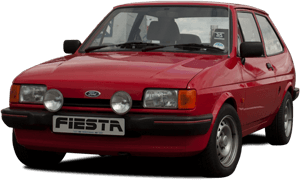Differences in the Mk2 Ford Fiesta bodyshell
Throughout it's production life of 1983 to 1989, the Mk2 Ford Fiesta bodyshell remained essentially the same. Like with any car though, Ford made some changes throughout to production in order to lower their costs or rectify issues that arose after production had already started. There are a few difference that you can use to check the age and model type, and help verify your Fiesta is genuine.
Low spec shells (Popular, Popular Plus, Bonus etc)
Low spec cars didn't have any wide side mouldings fitted, so the front wings, doors and rear quarter will not have been drilled for the wide plastic side mouldings. Internally the cars were fitted with only partial height door cards with an exposed strip of metal above. This exposed body colour metal will be free from any holes unlike higher spec vehicles which had locating holes for the door cards pre-drilled.
Cars that did not feature a brake servo are missing a bulkhead reinforcing plate that was designed to reduce flex in the brake bar assembly.
High Spec Shells (L, Ghia, Festival, Firefly etc)
High spec shells were fitted with external wide plastic side mouldings with a insert, due to these being riveted on, the bodyshell and doors were pre-drilled with holes at mid-height. The interior featured full-height door cards so the inner rear quarter panels and inner front door tops also featured extra holes to attach the trim with pop fasteners.
XR2 Shells
XR2 shells had two main differences which apply to all model years. The rear panel was a slightly different pressing, with a bulge included to make room for the larger 13"x6J spare wheel. The rear valance hides the bulge so lifting the boot boards and looking underneath the spare is the easiest way to see it.
The rear arches on the XR model were rolled from the factory to eliminate any rubbing. This can also be a bit tricky to see due to the plastic bodykit arches.
As well as these two differences, in order to fit the bodykit the Fiesta XR2 was also pre drilled with holes for fitting side skirts, valances, wheel arches and the boot surround spoiler. These were attached using a mixture of rivets and screw fastenings with plastic plugs.
Another visual change is that the XR2 had satin black painted window surrounds as standard. These were finished with a black adhesive pin stripe, a feature unique to this model variant. Interestingly even the black cars had this painted window surround.
Early Shells
Early Mk2 Ford Fiesta shells had a number of difference that were revised as time went on. The very first cars had more in common with the facelifted Mk1 version. Firstly there were no side repeaters, cars prior to 1986 didnt have the side indicator holes in the front wings. These were added as safety standards evolved.
The very first Mk2's produced (1983) had 2 sets of wider scuttle panel slotted holes with 20 holes in each in comparison to the later which had 27 slimmer holes.
There are also a number of small and less noticeable details that distinguish earlier cars from later ones:
- The inner wing to outer wing engine bay channel was drilled in four places for wedge shaped rubber bonnet spacers which were removed on later models.
- Due to no rear seat belts being fitted, plastic plugs were inserted into the holes under the rear bench seat.
- Metal floor bungs were fitted to 1983/84 cars as opposed to plastic ones.
- The vin plate was mounted vertically on the bulkhead to the left off the bonnet catch plate (at 90 degrees to how you would normally read it).
- Two large round rubber bulkhead plugs were fitted as opposed to the later plastic
- No plastic splash guards were fitted under the front inner wings
Other ways to verify your car
Our register of Ford Fiesta's has proved useful on several occasions when it comes to identifying suspicious cars that have seemingly radically changed. The register is maintained both to aid future Fiesta buyers and provide a historic record.

